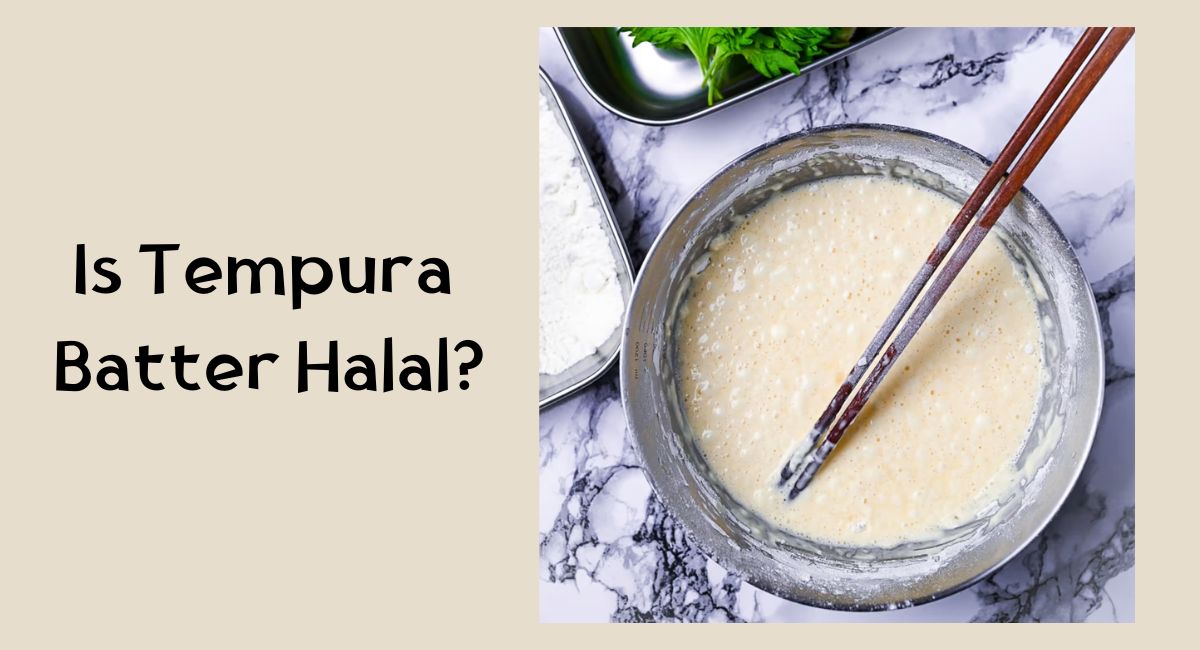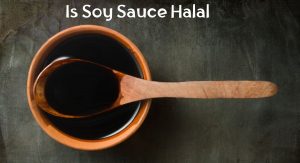In today’s diverse and multicultural world, where dietary preferences and religious observances play a significant role, it is essential to examine the halal status of various culinary practices and ingredients.
Among the many delectable dishes enjoyed worldwide, tempura stands out as a popular Japanese creation, renowned for its crispy, golden coating.
However, as the Islamic faith adheres to specific dietary guidelines, a pertinent question arises: is tempura batter halal?
In this article, we delve into the intricacies of tempura preparation, its key ingredients, and the underlying principles of halal food consumption, aiming to shed light on whether tempura can be enjoyed by individuals seeking halal-certified culinary experiences.
Is Tempura Batter Halal
The halal status of tempura batter depends on its ingredients and preparation methods. In general, tempura batter can be considered halal if it does not contain any prohibited ingredients like pork or alcohol and is prepared in accordance with Islamic dietary laws. The basic version of the batter contains only water, eggs, and all-purpose flour all of which are considered halal.
It’s important to check the specific ingredients listed on the packaging or inquire with the manufacturer or supplier to ensure the halal status of a particular tempura batter product.
Some brands offer halal-certified tempura batter mix, indicating that their products meet the requirements of halal standards. These certified products provide assurance to consumers following halal dietary guidelines.
When eating out, it’s also important to ask about the preparation of the dish and make sure that no haram ingredients were used in its cooking. Many restaurants use tempura batter that includes alcohol as an ingredient. Moreover, some restaurants may fry their tempura batter in oil that contains animal fat or lard. If this is the case, you should avoid the dish and look for an alternative option.
In conclusion, tempura batter typically does not contain haram ingredients, but it’s important to check the ingredients list or inquire about how the dish is prepared when ordering from a restaurant. Doing so will help ensure that you are eating halal food and avoiding any haram ingredients. It is also recommended to look for halal certification labels or consult reliable halal certification organizations for more specific information about the halal status of a particular brand or product.
Dive into an insightful exploration of the topic is beer batter halal, exploring the key elements that determine the permissibility of beer batter in Islamic dietary guidelines. Gain a deeper understanding of the ingredients, brewing process, and potential considerations for Muslims seeking to navigate this culinary aspect. Uncover the nuanced perspectives and scholarly opinions surrounding beer batter and make informed choices about its halal suitability.
What is Tempura Batter
Tempura batter is a crucial component in Japanese cuisine, particularly in the preparation of the popular dish known as tempura. Tempura refers to food items, such as seafood, vegetables, or sushi, that are lightly battered and deep-fried to create a crispy coating. The batter used in tempura plays a significant role in achieving the desired texture and flavor.
The history of tempura batter is an interesting mix of cultural influences. The technique of deep-frying food with a light flour batter, known as tempura, originated in Japan but has roots in Portuguese cuisine. Portuguese merchants introduced a frying technique called “tempero” to Japan in the 16th century. This method involved coating foods with flour and then frying them.
The original Portuguese recipe for tempura consisted of minced balls of meat and fish, along with vegetables. However, when this cooking style was adopted by the Japanese, they made modifications to the batter and fillings, creating their own version of tempura. The Japanese lightened the batter and diversified the fillings, incorporating ingredients such as shrimp, sweet potatoes, and shiitake mushrooms.
Tempura gained popularity in Japan due to the country’s close ties to Buddhism, which promoted a vegetarian diet. In the region of Kyoto, where vegetables were abundant, tempura became a favored method of frying, and vegetable oils, including sesame oil, were used for deep-frying.
The unique fluffy and crisp texture of tempura is achieved by the traditional method of mixing the batter in small batches using chopsticks for only a few seconds, leaving lumps in the mixture. The presence of lumps, combined with the cold temperature of the batter, contributes to the distinct structure of tempura when it is cooked.
Today, tempura remains a beloved dish in Japan and is popular in Japanese restaurants worldwide. Its history exemplifies the cultural exchange and adaptation of culinary techniques across different regions and cuisines.
Here are some popular dishes that are commonly prepared using tempura batter:
- Shrimp Tempura: Shrimp tempura, known as Ebi no Tempura in Japanese, is one of the most popular and widely recognized tempura dishes. The shrimp is coated in the light and airy tempura batter and deep-fried to perfection. It is often served as an appetizer or part of a tempura assortment.
- Vegetable Tempura: Vegetable tempura is another popular variation of tempura. Various vegetables like asparagus, bell peppers, carrots, sweet potatoes, and lotus roots are commonly used for vegetable tempura. The vegetables are thinly sliced, dipped in the tempura batter, and fried until crispy.
- Mushroom Tempura: Tempura batter is also used to fry mushrooms, providing a delicious and crispy coating. Commonly used mushrooms for tempura include shiitake, enoki, and king oyster mushrooms.
- Tempura Donburi: Tempura donburi, or tendon, is a popular Japanese rice bowl dish. It consists of a bowl of steamed rice topped with assorted tempura, including shrimp, vegetables, and sometimes seafood like squid or fish.
- Tempura Udon: Tempura udon is a dish where tempura, usually shrimp and vegetables, is served on top of a hot bowl of udon noodles in a savory broth. It is a comforting and satisfying dish enjoyed in Japan.
- Tempura Sushi Rolls: In some cases, tempura-battered ingredients like shrimp or vegetables are used as fillings in sushi rolls. The tempura provides a crunchy element to the rolls, adding texture and flavor.
- Tempura Kakiage: Tempura kakiage is a type of tempura made by thinly slicing various vegetables and mixing them together before dipping them in the tempura batter and frying them as a cluster. It results in a beautiful and flavorful vegetable fritter-like dish.
These are just a few examples of popular dishes that can be made using tempura batter. The versatility of tempura allows for creativity and experimentation with different ingredients and combinations to suit individual preferences and culinary traditions.
What Does Tempura Batter Consist Of

Tempura batter consists of a few key ingredients that are commonly used to achieve its unique texture and flavor. The basic components of tempura batter are:
- Low gluten flour: Tempura batter uses low gluten flour, such as cake flour or plain flour, to create a light and crispy texture.
- Starch: Starch, such as potato starch or cornstarch, is added to the batter to create a crispy coating.
- Egg: Egg is added to the batter to help bind the ingredients together.
- Ice-cold water: Ice-cold water is added to the batter to create air pockets, resulting in a light and airy texture.
- Baking powder: Baking powder is added to the batter to help create a crispy texture.
- Oil: A small amount of oil may be added to the batter to help create a crispy coating.
- Spices: Some recipes may call for spices, such as salt and pepper, to add flavor to the batter.
These ingredients are combined to create a light and airy batter that results in a crispy coating when fried.
The traditional method of preparing tempura batter involves mixing the ingredients in small batches using chopsticks for only a few seconds. This technique intentionally leaves lumps in the batter, which, along with the cold temperature of the batter, contribute to the fluffy and crisp texture of tempura when cooked.
While the basic recipe for tempura batter consists of flour, egg, and ice water, there are variations and additions that can be made to enhance the flavor and texture. Some recipes suggest adding other ingredients such as beer, starch (potato or cornstarch), carbonated water, or vodka to improve the crispiness and lightness of the batter.
For instance, vodka and carbonated water are sometimes used to make the batter more aerated and light. Potato starch is known to make the batter lighter and fluffier. These additions can help achieve the desired characteristics of tempura batter.
It’s worth noting that pre-made tempura mixes are also available in some specialty stores, which can be used as a convenient alternative to homemade batter. These mixes may contain additional ingredients or seasonings, so it’s important to check the specific product for its composition.
How to Make Tempura Batter
To make tempura batter, there are several key steps and tips that can help you achieve the best results. Here’s a comprehensive guide
- Ingredients: The main ingredients for classic tempura batter are water, eggs, and all-purpose flour. However, there are variations and additional ingredients you can use to enhance the flavor and texture of the batter, such as beer, starch (potato or cornstarch), or soda water. These ingredients can contribute to a lighter and crispier batter.
- Sifting the flour: Before mixing the batter, it’s recommended to sift the flour. This helps make the flour lighter and easier to incorporate into the batter. Sifting also helps minimize gluten formation, which contributes to a crisp texture.
- Mixing the batter: To prepare the batter, you can use a whisk or chopsticks. Traditional methods suggest mixing the batter in small batches for only a few seconds, leaving lumps in the mixture. This technique, along with using cold batter, helps achieve the unique fluffy and crisp texture of tempura.
- Ice water: For a crispy tempura coating, it’s recommended to use ice water instead of room-temperature or tap water when making the batter. The cold temperature of the batter contributes to the desired texture when frying.
- Preparing the ingredients: It’s important to prepare all the ingredients you plan to deep-fry before mixing the batter. Cut the vegetables or seafood into appropriate sizes and pat them dry to remove excess moisture, which can affect the crispiness of the batter.
- Heating the oil: Fill a large, heavy-bottomed pot with vegetable oil and heat it to the desired temperature, typically around 375°F (190°C). Using a candy thermometer can help ensure the oil is at the right temperature for frying.
- Dipping and frying: Dip the prepared ingredients into the batter, making sure they are evenly coated. Carefully place the coated ingredients into the hot oil and fry until golden brown and crispy. It’s important not to overcrowd the pot, as this can lower the oil temperature and result in greasy tempura.
- Drain excess oil: Once the tempura is fried, transfer it to a paper towel-lined plate or a wire rack to drain excess oil.
- Serving and dipping sauce: Tempura is typically served hot and can be enjoyed with a dipping sauce called tentsuyu. Tentsuyu is a flavorful sauce made from ingredients such as soy sauce, mirin, and dashi. Grated daikon radish can also be served alongside tempura to add a refreshing element.
Good tempura batter should have certain characteristics that ensure the dish comes out perfectly. Below, we will discuss four of the key characteristics of tempura batter that will help you achieve the ideal result.
- Texture: The texture of tempura batter is an important characteristic. Good tempura batter should be pale blond, with an extraordinarily lacy, light, and crisp coating. The batter should be thin and crispy, with a delicate crunch that does not overwhelm the food inside. Achieving this texture requires a certain technique, as the batter needs to be mixed just enough to coat the ingredients and no more.
- Airiness: The second important characteristic of tempura batter is airiness. The batter should be extra airy, thanks to the cold club soda used. By adding club soda, you create a chemical reaction that releases carbon dioxide gas, producing bubbles that create a light and airy batter. The airiness of the batter ensures that the food inside is cooked evenly and remains crispy.
- Lightness: The key characteristics of a tempura-style batter are extreme lightness of color and texture. Achieving this lightness is a task that requires practice, as the perfect balance is achieved through careful experimentation. Too much flour, and the batter will be too thick, while too little will make the batter too thin. Achieving the right balance is key to a perfectly cooked tempura dish.
- Delicate: The final important characteristic of tempura batter is its delicate nature. Tempura batter is very delicate and easy to fail. To make sure the batter sticks to the ingredients and doesn’t fall apart, the ingredients must be dry and at room temperature before they are dipped into the batter. Also, the temperature of the oil needs to be just right – too hot, and the batter will burn, while too cool, and it won’t cook properly.
Remember, practice and experimentation can help you refine your tempura batter-making skills. Adjusting the ratio of ingredients or incorporating different additions can lead to personalized variations of tempura batter.
Tempura vs Regular Batter
| Aspect | Tempura Batter | Regular Batter |
|---|---|---|
| Composition | Primarily made with all-purpose flour (plain flour) | Flour, liquid (water or milk), eggs, and spices |
| Texture | Unique fluffy and crisp texture when cooked | Varies depending on desired texture and consistency |
| Mixing Technique | Quick mixing with chopsticks, leaving lumps in the mixture | Mix ingredients thoroughly |
| Cold Temperature | Utilizes cold batter temperature | No specific requirement |
| Frying Technique | Cooked in agemono (deep-frying) with quick submersion in hot oil | Deep-fried until golden brown |
| Usage | Specifically used for making tempura, a Japanese dish | Versatile, used for various fried foods |
| Dipping Sauce | Often served with tentsuyu, a complementary dipping sauce | Depends on the dish and personal preference |
Tempura and regular batter are both used to coat food before frying, but they have some differences in terms of composition, origin, and cooking techniques.
Regular batter is a mixture of flour, liquid (such as water or milk), and other ingredients like eggs and spices. It can be thick or thin, depending on the desired texture and consistency. Regular batter is commonly used for coating foods like chicken, fish, or vegetables before frying.
On the other hand, tempura batter is a specific type of batter used in Japanese cuisine for making tempura, a dish made by deep-frying vegetables, seafood, or other foods in a light batter. Tempura batter has a unique fluffy and crisp texture when cooked. It is traditionally made in small batches, mixed quickly using chopsticks for only a few seconds, leaving lumps in the mixture. The use of cold batter temperature is another characteristic of tempura batter that contributes to its distinctive texture.
While regular batter can be made with various types of flour, tempura batter is typically made with all-purpose flour (plain flour). Tempura batter also usually includes a combination of egg and water in a 1:1 ratio by volume. Additionally, some variations of tempura batter might incorporate other ingredients like baking powder or cornstarch for added crispness.
In terms of frying, regular batter-coated foods are typically deep-fried until golden brown, while tempura is traditionally cooked in a deep-frying technique known as “agemono.” In agemono, the food is quickly submerged in hot oil and cooked at a high temperature, resulting in a light and crispy exterior. Tempura is often served with a dipping sauce called tentsuyu, which adds flavor and complements the delicate taste of the fried ingredients.
Frequently Asked Questions (FAQs)
1. Is tempura batter vegan?
Traditional tempura batter typically contains eggs, making it non-vegan. However, there are vegan-friendly alternatives available that do not include eggs. These vegan tempura batter recipes often use ingredients like flour, cornstarch, baking powder, salt, and sparkling water to achieve a light and crispy texture. It’s important to note that not all tempura batter is vegan, and it’s advisable to check the specific ingredients or look for vegan-friendly options when purchasing or preparing tempura batter.
2. Does tempura batter have alcohol?
No, tempura batter does not typically contain alcohol. The main ingredients in tempura batter are flour, water (or sparkling water), and sometimes additional seasonings or spices. However, it’s always recommended to check the specific recipe or product label to be certain, as variations may exist.
3. Does tempura batter have egg?
Traditional tempura batter does contain eggs as one of the ingredients. The eggs help create the desired texture and structure of the batter. However, vegan versions of tempura batter can be made without eggs, using alternative ingredients such as flour, cornstarch, and sparkling water. It’s important to check the specific recipe or product label to determine if eggs are included.
4. Is tempura batter healthy?
Tempura batter, like any fried food, is typically high in calories and fat due to the deep-frying process. The batter absorbs some of the oil during frying, which can contribute to its calorie content. However, the use of a light batter and quick frying technique can result in less oil absorption compared to heavier batters or prolonged frying. It’s worth noting that the overall healthiness of tempura depends on various factors, including the ingredients used, the quality of the oil, and portion sizes. Moderation and balance are key when including tempura or any fried food as part of a healthy diet.








